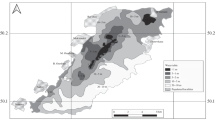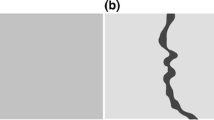Abstract
Salt crystallisation is a major problem of deterioration in historic stone buildings, monuments and sculptures. The capillary rise of soil water is one of the primary sources of salts in stone structures, which evaporates leaving the salts behind. It has been noted that the spatial distribution profile of different species of salts crystallised in historic stone buildings is not homogeneous, i.e. different salts crystallise at different locations. The capillary transport and inhomogeneous spatial distribution of different salts in the porous building materials has been considered to be a result of solubility-dependent crystallisation; however, the factors responsible for this phenomenon are not clearly known. This paper aims to investigate the factors influencing the differential distribution of salts during capillary rise of soil water. In this study, the capillary transport of salts was simulated on two different sandstones—Locharbriggs, a Permo–Triassic, red sandstone and Stoke Hall, a Carboniferous, buff sandstone. The experiments were carried out under controlled environmental conditions to eliminate the possibility of evaporation-driven crystallisation of salts depending on their solubilities. The results indicate that fractionation or differential distribution of salts takes place even in the absence of evaporation and crystallisation. The sandstones exhibit properties like an ion exchange column, and ionic species present in the salt solution show differential distribution within the porous network of sandstone.




Similar content being viewed by others
References
Appelo CJA, Postma D (2005) Geochemistry Groundwater and Pollution, 2nd edn. A. A. Balkema, Leiden
Arnold A (1982) Rising damp and saline minerals. In: Gauri KL, Gwinn JA (eds) Fourth international congress on the deterioration and preservation of stone objects. Louisville, pp 11–28
Arnold A, Zehnder K (1990) Salt weathering on monuments. In: Zezza F (ed) Proceedings of the 1st international symposium on conservation of monuments in the Mediterranean basin. Bari, pp 31–58
Arnold A, Zehnder K (1991) Monitoring wall paintings affected by soluble salts. In: Cather S (ed) Proceeding of the symposium on conservation of wall paintings, The getty conservation institute. Los Angeles, pp 103–136
Baraka-Lokmane S, Main IG, Ngwenya BT, Elphick SC (2009) Application of complementary methods for more robust characterization of sandstone cores. Mar Petrol Geol 26:39–56
Blatcheley ER, Thompson JE (2007) Groundwater contaminants. In: Delleur JW (ed) The handbook of groundwater engineering, 2nd edn. CRC Press, 17–1, pp 17–32
Juo ASR, Franzluebbers K (2003) Tropical soils: properties and management for sustainable agriculture. Oxford University Press, Oxford, p 36
Matteini M (1991) In review: an assessment of florentine methods of wall painting conservation based on the use of mineral treatments. In: Cather S (ed) Proceeding of the symposium on conservation of wall paintings, The getty conservation institute. Los Angeles, pp 137–149
Pandey SC, Pollard AM, Viles HA, Tellam JH (2014) Influence of ion exchange processes on salt transport and distribution in historic sandstone buildings. Appl Geochem 48:176–183
Polomski J, Fluhler H, Blaser P (1982) Accumulation of airborne fluoride in soils. J Environ Qual 11:457–461
Rodriguez-Navarro C, Doehne E (1999) Salt weathering: influence of evaporation rate, supersaturation and crystallization pattern. Earth Surf Proc Land 24:191–209
Ruiz-Agudo E, Mees F, Jacobs P, Rodriguez-Navarro C (2007) The role of saline solution properties on porous limestone salt weathering by magnesium and sodium sulphates. Environ Geol 52:269–281
Wissmeier L, Barry D (2008) Reactive transport in unsaturated soil: comprehensive modelling of the dynamic spatial and temporal mass balance of water and chemical components. Adv Water Resour 31:858–875
Acknowledgements
The authors are thankful to Mr. Chris Doherty and Dr. Peter Ditchfield (Research Laboratory for Archaeology and History of Art, University of Oxford), Ms. Hong Zhang, Dr. Mona Edwards and Mr. Christopher Jackson (Oxford Rock Breakdown Laboratory, University of Oxford) for all their assistance in carrying out this research. The authors acknowledge the financial support received for this research from the Dorothy Hodgkin Postgraduate Awards, the Charles Wallace India Trust and the Exeter College (University of Oxford). The constructive feedback received from the reviewers is also acknowledged.
Author information
Authors and Affiliations
Corresponding author
Rights and permissions
About this article
Cite this article
Pandey, S.C., Pollard, A.M. & Viles, H.A. A simulation study of capillary transport, preferential retention and distribution of salts in historic sandstone buildings. Environ Earth Sci 76, 434 (2017). https://doi.org/10.1007/s12665-017-6769-4
Received:
Accepted:
Published:
DOI: https://doi.org/10.1007/s12665-017-6769-4




